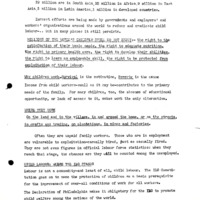CHILD LABOUR IS STILL A FACT
Item
- Title
- CHILD LABOUR IS STILL A FACT
- extracted text
-
SDA-RF-CH-4.12
HL'AL‘H CELl
‘ - ■ jSO Oi) J
CHILD LABOUR IS STILL A FACT
Our world o± children includes some one and a half billion under
15 years of age.
Over 52 million children between 7 and 15 are working.
29 million are in South Asia,10 million in Africa,9 million in East
Asia,3 million in Latin America,.! million in developed countries.
Earnest efforts are being made by governments and employers1 and
workers1 organisations around the world to reduce and eradicate child
labour-., but in many places it still persists.
MILLIONS OF THE WORLD'S CHILDREN STILL DO NOT ENJOY:- the right to the
satisfaction of their basic needs, the rightto adequate nutrition,
the right to priinary health care,.the right to^develop their abilities.
the right to learn an employable skill, the right to be protected from
exploitation of their labour.
Why children workySurviyal is the motivation, Poverty is the cause
Income from child workers-small as it may be~contributes to the primary
needs of the family.
For many children, too, the absence of educational
opportunity, or lack of access to it, makes work the only alternative.
WHERE THEY WORK
On the land and in.the village, in ..and around the home, or,on the streets,
in crafts and trading, on plantations, in mines and factories.
Often they are unpaid family workers.
Those who are in employment
are vulnerable to exploitation-casually hired, jiust as casually fired.
They are not even figures in official labour force statistics; when they
reach that stage, the chances are they will be counted among the unemployed
CHILD LABOUR; WHERE THE LLP STANDS
Labour is not a commodity-and least of all, child labour.
The ILO Consti
tution goes on to name the protection of children as a basic prerequisite
for the improvement of over-all conditions of work for all workers.
The Declaration of Philadelphia makes it obligatory for the LEO to promote
child welfare among the nations of the world.
THE CHILD is not a "small adult" but a fragile personality to be nurtured
into the mature citizen and worker of tomorrow, needs the protection of a
statutory minimum age for admission to employment; needs schooling, train
ing and guidance-gateways to personal fulfilment in adult life.
- 2 -
THE YOUNG WORKER needs a fair.wg.£g_and strict limitation of working hours,
^AlA^2S£^w,qrtsing_and_living conditions and environment, and to be
ghieA(~g.d from.exposurg to arduous, unhealthy and dangerous work; needs
fair and effective apprenticeship systems.
LAW AND SOCIAL POLICY:
LLO INSTRUMENTS FOR CHANGE
Since its origin in 1919 the ILO has encouraged countries to achieve pro
gress through law and social policy.
International Labour Conventions and
Recommendations, supported by action to help create the conditions in which
they can be effectively put into national practice, are the ILO's instru
ments for stimulating this progress.
Conventions and Recommendations are aimed at the elimination of child
labour, the provision of medical safeguards and of vocational guidance and
training, as well as the outlawing of night work by young persons.
The HO Convention and Recommendation adopted in 1973 on Minimum Age for
Admission to Employment call for adoption of a national policy to abolish
child labour and for progressive raising of the minimum age for work.
They
allow for gradual entry into working life, distinguishing between
light work under conditions safeguarding health, schooling and training;
generally not to be allowed before 15 ?<ears, in developing countries not
before 12 years;
work not dangerous to health, safety or morals; normally not before 15 years,
in developing countries not before 14 years; hazardous work; generally not
before 18 years, in certain cases as from 16 years.
The Convention and Recommendation require effective enforcement of minimum
age legislation.
The Recommendation sets out a series of social policies
to attack the economic causes of child labour.
The Minimum Age Convention
has so far been ratified by 18 of the ILO's 140 member States.
jtkExiiH THE ILO's CONTINUING ACTION
The ILO's over-all programme helps improve economic and social conditions,
and thus eliminate the need for child labour.
Action advocated includes:
enforcement of existing legislation including strengthening ofJLabour inspec
tion; social and economic assistance to families to enable children to .go
to school;, measures to strengthen social institutions for the family andi to
protect those without family; general compulsory education and traini^adg£tpd
to local conditions; promoting awareness of the physj,cal,mental and moral
dangers to child development provoked by chnd labguriJbransforming ecgnomlc,
- 3 -
social and cultural.structures in order to remove the need for children
to work.
This action will continue throughout the International Year
of the Child and beyond, until there is no more child labour.
- Media
 SDA-RF-CH-4.12.pdf
SDA-RF-CH-4.12.pdf
Position: 1929 (5 views)
